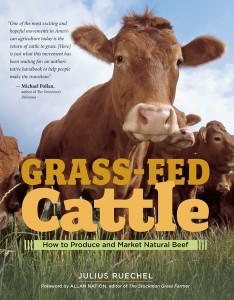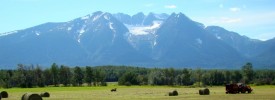 By Curt Gesch, June 2014
By Curt Gesch, June 2014
If you’re interested in looking at your beef operation afresh, look no further than this book. Julius Ruechel covers everything from the history of ungulate herding instincts to genetics, climate, forages, watering systems, pests, calving and more. In the marketing section he surveys land and equipment needs, raising stockers, finishing beef, financial planning, and making marketing plans.
The book could easily have been bound as two volumes, not because 350+ pages is too long, but because there is too much to digest (pun intended) with one reading, even an extended reading.
The fundamental principle of this fine book are these: Let cattle express their instinctual behaviours as ruminants and herd animals and you will produce healthy animals with minimal machine costs. Healthy animals give you options in marketing your beef as high-quality, healthy and tasty meat through a number of markets.
Right from the beginning Ruechel identifies his approach as one that is attuned to natural cycles. He looks to the great herds—bison, caribou, etc.—for insight into how to encourage cattle to use their instincts to thrive, as opposed to an agricultural system that fits the animals into its mold.
The implications will be challenging, frustrating, maybe even maddening, for some ranchers. Early summer grazing, says Ruechel, is the way to go: calves are born on grass, not snow or mud; scours is virtually eliminated; and predators have lots of easier prey—rabbits, 四人打麻将 voles, birds, for example. Herding behaviour, suggests Ruechel, means a sort of competitive grazing that creams the grasses, disturbs the soil as hooves bring organic and mineral matter together while hoof may also open the sod to let air and moisture enter easily. You find out very soon that Ruechel is not talking here about herds held in yards, major efforts and cash used to store food that is brought to cattle, or feedlots that use grain to put on the final pounds and fat. He is talking about grazing—what cattle do naturally.
Fencing, water supplies, and attention to grass are the emphases Ruechel puts first. He suggests that machinery needs should start with a quad, and that herding may make even one tractor unnecessary. At this point, a reader may begin to add amazement to earlier frustrations as Ruechel continues. Cattle, says Ruechel, are naturally “programmed” to have times of higher and lower quality foods, but they make growth spurts that helps them regain body condition. In winter, a cow may have a lower metabolic rate but, come spring, her metabolism ramps up and she is able “to quickly make up for food shortages and even catch up to those that didn’t experience such a shortage.”
As far as hay and silage goes, Ruechel recommends a goal of year-round grazing, including grazing-through-the-snow if at all possible, which means that it is often much more economical to buy feed when winter pastures aren’t sufficient. Having this feed placed in the field where you want it may even eliminate the need for a tractor/loader. Ruechel doesn’t say as much as I would like about the types of snow and depth. His own ranch is operated according to his principles in Yukon, but heavy, wet or heavily crusted snows may be an impediment to winter grazing to a significant degree.
I also wonder about the “purity” of his grass-fed philosophy. He suggests that even a little grain negates the health benefits (for the cow as well as for human consumption) of a grass-fed diet. Cattle grazing mature grass, however, certainly harvest seeds which is nothing more than the “grain” of the grass. I could not find a satisfactory explanation in this book about why a handful of grain now and then would defeat the purpose of the system.
The closing third of the book is extremely practical. It gives charts and models and explanations of how to do the ration planning of your operation, various marketing strategies, and so on. Because Beyond the Market and other sponsors have provided excellent workshops on these topics in the last few years, I will give a blanket endorsement to Ruechel’s ideas with going into detail.
An absolutely fascinating part of this marketing section is a series of case studies in marketing. Here are the matched pairs of cities showing how marketing might be tailored to needs of various sized and located markets:
- Helena, Montana/Grande Prairie, Alberta.
- Seattle, Washington/Vancouver, British Columbia.
- Lewistown, Montana/Kindersley, Saskatchewan.
Ruechel shows how the nature of the various communities will provide successful marketing solutions. For example, in oil exploration areas, companies may be interested in providing lots of red meat for their employees in camps. In small prairie towns, the prevalence of deep freezers (because many people already use them for wild game) may direct sales to offering sides of beef rather than individual cuts.
Grain-Fed Cattle ends with a glossary which helps to make the book’s knowledge acceptable to novices as well as those with lots of experience. I would recommend that ranchers check out the book at a local library and consider buying a copy as a home-encyclopedia of a holistic way of raising land and cattle that arises out of respect for animal and land, while providing an acceptable income and way of life for the farmer or rancher.
—
Curt Gesch is a writer, farmer, and musician. He and his wife, Betsey, own 153 acres in Quick, B.C. and publish an e-newletter called Just Farmers(Contact [email protected] for information).






